






Dear seafarers,
Recent events, natural or otherwise, have had unprecedented effects on our globalized world. For the most part, these events have impacted negatively on industry and have caused hardship across the board. Disrupted supply chains, bottlenecks and shortages, to name but a few problems we have had to face, have led to the feeling that humanity is in a state of flux.
There is, however, a silver lining. Our industry, on which the world depends to such a great extent, has proved its resilience in the face of adversity, and our Seafarers have been at the forefront of this resilience. They have performed their duties stoically and have kept up their spirits by focusing on the positive as exemplified by M/V Alliance’s Chief Cook, Mr Glenn Limotan, and the galley crew, who share their recipe for delicious monggo soup.
Similarly, the latest Best Practice campaign, as reported in the Safety First contribution, has demonstrated that concentrating on making creative solutions to increase safety can act as a buffer to potentially negative external circumstances. This, of course, does not mean that there is a lack of empathy; it simply means that through the adoption of a viable coping mechanism, they prevent their objectives from being undermined.
Other articles that imply the need to maintain a positive attitude are to be found throughout this issue of Wavelength. Again, this does not imply any insensitivity towards those most affected by
recent events. Indeed, the Nostalgia section firmly indicates that our thoughts are with those in dire straits.
I would like to thank all the contributors for their insightful submissions and the enthusiasm with which they were written. Three new contributors, Captain Delson Roche and Maria Malegou together with Maria Vamvaka, joined the growing list and submitted pieces of a high standard. The former continued the trend of our Captains being able to produce pieces of great interest that hold the reader’s attention, and the latter gave a marvellous account of the visit to M/V Coral Island, which clearly showed how our ship and shore personnel share values and exhibit mutual respect of the highest order. Thanks are also due to Eleni Mathioudaki, whose piece on smartphones hits the nail squarely on the head. Last but certainly not least, I wish to thank Evaggelos Kollintzas for providing the photos from his archive that appear in the Survival at Sea section.
I sincerely hope that you enjoy this issue of Wavelength. If you have any comments, suggestions or questions regarding the content, please do not hesitate to contact me at contact@wavelength.gr.
Best wishes, Nick Seaman

Twenty Company Seafarers were promoted in the third quarter of 2021. The list of promotees along with their vessels and promotion details in chronological/alphabetical order is shown in the table below.
The officers and ratings listed above are at different stages in their seafaring lives, but they have one thing in common, and that is their advancement in their careers. It is a firm indicator that they are striving to do their best for themselves, their families and the Company with which they have formed a bond based on mutual trust and respect.
Disclaimer: The
Congratulations are due to each and every one of these Seafarers on their promotions which will serve as a springboard for further progress. Once again, our Seafarers’ efforts are to be praised, continuously recognised and never taken for granted. Thank you all for your loyalty and your commitment to carrying out your duties both safely and efficiently.
• Design-Production: www.remdesign.gr
We wish to acknowledge and congratulate our shore employees that have reached a significant working anniversary with our group during the past quarter, namely:
We praise you for your hard work and thank you for your loyalty!
M&M are not the usual multi-coloured chocolates but instead, our nickname during our visit on board M/V “Coral Island”. Let’s introduce ourselves properly, although we may have already met with some of you during the forums or spoken over the phone: My name is Maria Malegou (MGM). I’ve been with the Company for 25 years and am in charge of the Insurance & Claims Dept. for the whole fleet, whereas for the Freight Collection Dept., I specifically deal with the dry sector. Despite my visits on board the tankers, surprisingly, I had never had the chance to visit a dry bulker before!
I, Maria Vamvaka (MMV), joined the Company at the Reception Desk in 2019 and it is only now, in 2022, that I joined the Freight Collection Dept. /Insurance & Claims Dept. A new era has begun for me; it looks both exciting and promising yet very demanding. Thus, this visit (my first) was thrilling and gave me a snapshot of the vessel’s layout, her daily operation, as well as our Seamen’s life and routine on board.
It was on 23.01.22, a mild snowy day, when M&M along with Operator Alkis Polychronakis (AIP) arrived at Elefsis. The “Coral Island” was alongside and loading cement.


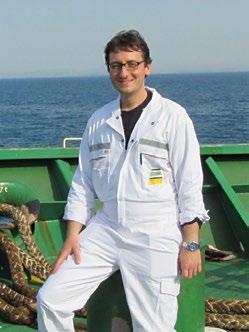
Captain Contreras and the Crew welcomed us on board and gave us the customary safety briefing. AIP, along with Fleet Supervisor Yannis Vakkas, gave us a quick tour of the accommodation, the Bridge and the Engine Room, where MMV was shocked by the size of the M/E. Later on, we went on deck where some of the cargo holds were being loaded. It was quite amazing to actually see and comprehend the volume of a cargo hold and how small you look next to it.
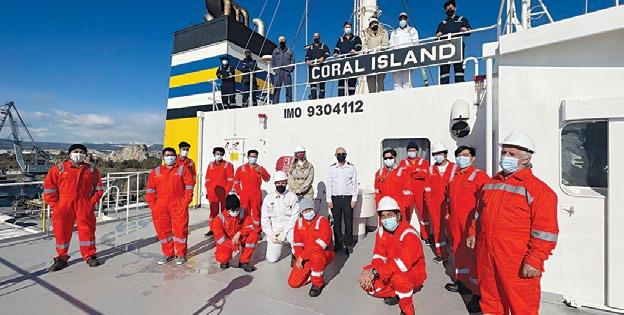
Both of us were impressed by the vessel’s cranes & grabs, important and critical equipment for her operations. Some people called us ‘’brave’’ as we visited the top of the Crane Control Room, where the whole operation of the cranes is monitored.
As for the fun part, we organized a ‘’Pitta cutting’’ followed by an open and engaging discussion with the whole of the Crew. Pitta (Cake) Cutting, is a Greek custom for the New Year. We had a cake with a lucky coin inside; the idea being that whoever finds the coin is destined to have good luck for the coming year.

The Master took responsibility for cutting the cake in equal pieces for all those present, including one piece for the “Coral Island” and one for St. Nicholas – the patron saint of seafarers. There was a lot of excitement and even some false alarms, but eventually the lucky recipient of the coin was 2/M Suggang Rannie. Congratulations once again and we wish you good health and safe voyages!
We would like to thank Captain Contreras and his Crew for extending to us such amazing hospitality despite the vessel being under loading operations and for making our visit most memorable.
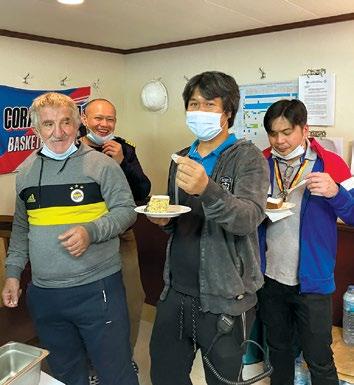

Lastly, a big thank you to our colleagues Alkis and Yannis for devoting some of their valuable time to take us around and
Dear All,
We are happy to present to you a close-up of the actual event of CENMAR’s Web Forum 2021, which took place on December 2nd, 2021 at Head Office.
The Covid-19 situation worldwide did not allow us to meet each other for one more year, and seems to be creating a new tradition with fleet vessels joining in live online and participating in the event along with hundreds of other participants from all over the world.
As in 2020, the set-up was based and organized in the Head Office meeting rooms in a one-day event, which consisted of presentations covering a wide range of subjects and updates from the industry.

explain the operation of various pieces of equipment in detail. We look forward to visiting more vessels and meeting with our Seafarers more often in the near future.


The Web Forum was streamed live to over 500 participants around the globe. The two rooms designated for the event were the “studio room” which broadcast the event live and the second room which accommodated the presenters and panelists.
The “studio room” was equipped with 4 computers, 3 cameras and microphones, 2 tablets, 2 large banners and a whole bunch of cables, as you will notice in the photos. These were handled by Mr. K. Lionis (ICT Officer) and Mr. A. Chandris (Forum Coordinator), along with each one of the presenters.
At the other end of the floor, in “the panelists’/presenters’ room”, the panelists monitored the event, ready to intervene and answer any questions. The panelists/presenters included Mr. A. Lambros, Mrs. E. Moretti, Mr. D. Fakiris, Mr. P. Bartzis and Mr. D.

Sarandis along with the presenters of each session during the Forum. Their presence was very important to the organization of the event as, first and foremost, they ensured - as observers - that the sound/video broadcast ran smoothly and that they could respond to all the queries the attendees had.
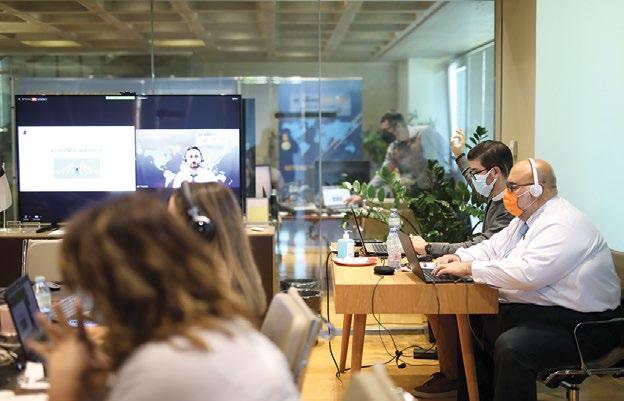
The panelists’/presenters’ room
The WebForum 2021 Team was Mr. A. Lambros, Ms. K. Fountouli, Mr. D. Sarandis, Mr. A. Chandris, Ms. M. Mothoniou, Mr. V. Manousakis, Mr. Y. Romanidis and Mrs. L. Kazazis, Ms. Chara Markatzinou, Capt. P. Kumar, Mrs. E. Moretti, Mr. Y. Razis with special guests Mr. P. Diakakis (TQC Consultant), Mr. Y. Procopiou, Mr. F. Christopoulos, Mr. C. Ellinas, Mr. D. Fakiris, Mr. K. Lionis, Mr. J. Sarlamis, Mr. P. Bartzis, Ms. F. Koutsochristou and all the other Head Office personnel that participated in the creation of the videos presented during the event
Once again, two of the most touching moments of the event occurred when a few fleet vessels joined and addressed the Forum live, and when the microphones from the 500+ attendees were switched on and everyone said “Hi” simultaneously. It was an amazing feeling to establish such a connection during a very difficult period for social events.

We are happy to announce that this was the second time the full event was recorded and shared with the whole fleet so that crew members can view it in their free time.
The Web Forum allowed us to connect with a large number of crew members and also remain safe during these difficult times. The event was intended to connect people and it achieved this aim, but we are really looking forward to seeing you again in person and spending some quality time together. Until then, BE AWARE, TAKE CARE, EVERYTIME, EVERYWHERE!

Avery big “Thank you” to all the readers who participated in our first interactive article and provided their feedback concerning what they want to read in this issue of Wavelength. The participation was impressive and an impressive number of readers voted for their preferences regarding the contents of the present article.
Furthermore, their valuable comments in the relevant section of the online questionnaire have been enlightening with respect to the readers’ preferences and the way they receive the articles. From the categories analyzed in the last Wavelength issue, we narrowed the submissions down to the following i.e. i.Operations / Maintenance ii. Ship-design & Hydrodynamics iii. Alternative Energy Sources and Fuels
So, without further ado, the results of the voting were the following:


By Yannis Vakkas
Taking into consideration the results, we have two “winners” and a “draw”.
Our readers chose Autonomous Ships from the “Operations/ Maintenance” category and Air Lubrication from the “Ship-design and Hydrodynamics” section.
• Autonomous Ships obtained an impressive 33.2% of the votes, which combined with the 17.4% for the EU Smart Ship project, is a clear indication that these revolutionary developments are attracting the attention of maritime stakeholders.
• Air lubrication garnered a surprising 29.3% of the votes. Although it has been on the market for quite some time, the recent restart as a strategy to reduce greenhouse gas emissions has given a new beginning to this technology.
As for the category of “Alternative Energy Sources and Fuels”, the votes were divided, so the last page of the article shows a comparison between the Top-3 choices. It is evident that reader interest was divided into three options, in a similar way to the current market environment in relation to the “Fuels of the Future”.
The only certain thing is that the maritime landscape is changing with the rising tides of technology. The trends that are emerging are doing so out of necessity and the complexity of the Regulatory environment for shipping. Shipbuilding, propulsion, alternative fuels, smart shipping, advanced materials, big data and analytics, robotics, sensors and communications will play a key role in how the maritime industry approaches new challenges and opportunities.
The drivers for these technologies are a balance between environmental and commercial necessity. It is certain that critical key changes in the Maritime Industry will take place in the coming years, so stay tuned.
Finally, as you will notice, instead of using the standard format of an article, we created infographics to display large amounts of data and information in the form of graphs and images. We consider this format entertaining, concise, and eye-catching. Moreover, all the information they contain is easily digested by the reader so they’re helpful, too. I hope you enjoy the contents!
As was the case with previous edition of Wavelength, you may communicate your valuable comments and feedback for present article by scanning the QR code below:
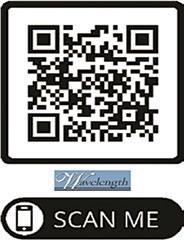






By Eleni Mathioudaki
The use of the smartphone has considerably changed the way we access information and interact with people around us. This single device offers us a variety of handy options such as making a phone call, taking a photo, paying a bill, listening to music, watching a video and using the Internet. Nevertheless, the fact that these activities can be carried out anywhere has made this technology more intrusive than any other has in the past. While the smartphone has made simpler the way people maintain their interpersonal relationships and carry out daily tasks, there are experimental studies showing that people often ignore those with whom they are physically interacting, while preferring to indulge themselves in their smartphone and to connect to “online others”. This is quite easy to identify, as when you take a walk outside or go to a restaurant, you will observe that a lot of people prefer to look at their phone screen instead of interacting with the physical environment or others.
But how did we get here? The first portable cell phone was invented on April 3, 1973 by Motorola engineer, Martin Cooper, who made the first ever cell phone call on the DynaTAC 8000X, by using a prototype weighing 2.4 lb (1.1 kg) and measuring 9.1 x 5.1 x 1.8 in (23 x 13 x 4.5 cm). This device offered a talk time of just 30 minutes and required 10 hours to recharge. The DynaTAC phone was priced at $3,995, which is the equivalent of $10,000 today.

Since 1973, cell phones have evolved in their capabilities and features, and are now an essential item in the hands of almost every individual. As a result, most of us rely on our smartphones to get through our daily plans, activities, and responsibilities. Moreover, this technology has become almost the only means of communication among us, taking away the more personal conversations that we used to have prior to its invention. Nowadays, when we plan to spend time with others we actually end up spending our time together on our smartphones. The figures speak for themselves:
• The typical cell phone user touches his or her phone 2,617 times every day. 2,617 times!
• Most people, on average, spend 3 hours and 15 minutes on their phones each day.
• Half of all phone pickups happen within 3 minutes of a previous one.
Here are some tips that will help you spend less time on your smartphone and communicate better with others (not through screens), thus leading to a healthier life style:
1. Change notification settings in order to keep them to a minimum: You can even turn off all notifications except for direct messages and mentions, which are the ones that come from real people.
2. Analyze your screen time and set time limits for the apps you use too much: Monitoring your usage from app to app is a great way to identify behaviours you want to change and have a general idea of the time you spend looking at a screen.
3. Grayscale: The Center for Human Technology says the "colorful icons give our brains shiny rewards every time we unlock". You can set your phone to grayscale so that you can train your mind to check your phone less.
4. Do not use your smartphone before bedtime to have healthy sleep. It is better not to keep your smartphone within reach at night. Rather than charging it on your nightstand, try charging it further away or ideally leave it in another room. Also you can stop using your phone as an alarm clock.
5. Delete applications: This applies to social networks in particular. If you need to, you can check your newsfeed in a browser.
6. Stay away from your phone after posting anything on social media. It’s usually very intriguing to check your likes and comments every 5 minutes.
7. Pause for a couple of seconds before grabbing your phone and try to analyze why you do it. Do you really need to use it or it is just a bad habit that it is hard to put an end to?
8. Hide the most distracting apps on the second page of the screen. You will be less tempted to use them.
In order to strive towards a more socially active way of life, starting from next year, we will introduce the tradition of the hidden coin in the New Year’s Day cake on board the vessels and a symbolic gift will be given to the winners. This can be a chance to communicate, spend quality time with each other and have real conversations, creating memories that will be happily remembered for the years to come.
Sources: https://www.sciencedirect.com/science/article/pii/S0167487017302520 “Journal of Economic Psychology” https://versus.com/en/news/cell-phone-history https://www.becomingminimalist.com/break-your-cell-phone-habit/ https://digitalcommons.odu.edu/cgi/viewcontent.cgi?article=1590&context=ots_masters_projects https://www.pcmag.com/how-to/how-to-wean-yourself-off-smartphones-and-social-media
Since the Nostalgia section has been welcomed so enthusiastically by all our vessels, it has been decided to take the next step by introducing a suggested new section called ‘’Voices from the Fleet’’. We would like to thank our Captain, Marvin Villanueva, for making this excellent suggestion during a leadership visit on board M/T Apnoia.
The first received is from M/V Alliance and our Chief Cook, Mr. Glenn Limotan, who shares with us the recipe for Monggo Soup, a traditional Filippino dish. We are looking forward to receiving your stories of life on board- not just recipes- so that ‘’Voices from the Fleet’’ becomes a popular section of Wavelength.
One of the traditional foods that Filipinos love is Monggo soup or Ginisang monggo.

The name literally means “sautéed mung bean”. However, the cuisine is actually a soup and that is why many people call it mongo soup.
The Tagalog word for mung bean is monggo, and it is primarily grown and originated in Asia and Southeast Europe. Monggo is used in a variety of ways in Asian cuisine. It is a delicious main meal frequently eaten with rice but it can also be a snack or merienda, even a dessert.
This hearty soup is excellent to eat as a main course or escorted with rice. Monggo beans are also called mung or green beans. Malungay leaves are very nutritious, and the tree is sometimes called a horseradish tree; use them to replace spinach if you can find them.
How to cook monggo soup:
Bring the mung beans and the water to boil until the beans are soft, for about 40 minutes.
Mash the beans. Set them aside.
Heat the olive oil in a large pot; cook and stir the onion and garlic in the hot oil over medium heat until softened, for 5 to 7 minutes.
Add the pork; season with salt and pepper. Continue cooking the mixture; cook for 2 more minutes.
Add the tomatoes; cook for another 3 minutes.
Reduce heat, and pour the chicken broth over the mixture to simmer in the broth for 5 minutes.
Add mashed beans to the soup; mix well and cook for another 5 minutes, stirring frequently to prevent any of the mixture from sticking at the bottom of the spot.
Add more chicken or water if the soup is too thick. Stir the spinach leaves into the soup and cook for 2 minutes more before serving.
Friday is monggo day for all Filipino mariners. It is the day when this exquisite delicacy is presented and thoroughly enjoyed by all. This savory recipe will make anybody feel at home, and it is the ideal cuisine to consume in both cold and hot weather. This hot dish provides warmth to the seafarers’ stomachs, as well as the proper nutritional balance they require.
Indeed, monggo soup is a hearty, budget friendly, and flavorful dinner that will fill you up and make you happy.
And finally here we go – pictures of our Galley Team
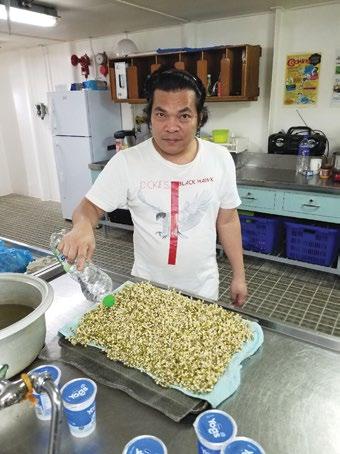

MESSAGE FROM THE DPA:
Keep up & “share” the good work! This is the meaning of Best Practices.
Dear seafarers,
Best Practices are a vital tool for the continuous improvement of our Safety Culture. During December 2020 a Health & Safety Campaign was launched to IDENTIFY, COLLECT and SHARE Safety Best Practices in common areas of Risk Assessment across the Fleet. The Campaign ended in June 2021 and another one commenced in the 2nd semester of 2021, and was concluded at the end of December 2021. We have received your ideas that were submitted with a lot of enthusiasm from most of our Fleet Vessels! Our shore personnel in the relevant Departments have reviewed all your Best Practices. All of your suggestions have been great. However, we needed to short list them so that we can easily share:
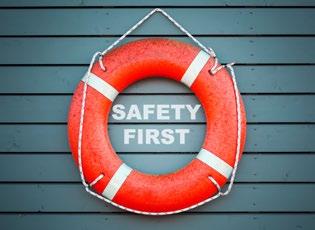
a. The Top Best Practices, i.e. the winners of the award, which are 12 in number and have been initiated by 7 fleet vessels.
b. Out of the 12 finalists, we have then chosen the number ONE!
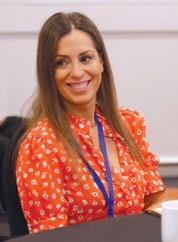
As a token of our appreciation, all of the Officers/Crew who were on board the specific vessels when one of the 12 Top Best Practices was reported will be awarded an Internet card.
The Officers/Crew on board the vessel providing the Best of the Top Best Practices will receive twice the aforementioned prize!
M/T CE-Hamilton
1. USE SMALL TROLLEY ON DECK
As per Code of Safe Working Practices for Merchant Seafarers 2015 Ch.10 MANUAL HANDLING ON DECK, the crew spend a lot of time and effort transferring heavy and not so heavy objects and that can lead to a loss of working capacity, curvature in body posture and personal injury. Often crewmembers request assistance and distract others from their work. In the workshop on our ship a small trolley was made. Our suggestion: Use a small trolley on deck to transfer heavy and not so heavy objects over long distances during the working day and cargo operations. A small trolley on deck reduces the risk of curvature in body posture and injury from hazardous manual handling during the transfer of heavy or not so heavy objects over a long distance. Always keep in mind that tools and equipment used on deck should be either made of non-sparking materials, or be properly lined in order to avoid the risk of ignition by friction.
2. SPORT BARS IN GYMNASIUM
Usually after the working day many crewmembers want to go to the gymnasium and do various exercises to maintain their physical health. Thus the fitter installed a sport bars in the gymnasium.
Sport bars is a valuable training apparatus. Physical exercise on sport bars allows the tension built up throughout the day to be released. Regular training on the bars improves posture, teaches muscles to work in a coordinated manner, develops power and stamina, strengthens the backbone and increase endurance.
3. GLOVES RACK
Installing such racks will lead everyone to take responsibility for a safe working environment and take care of themselves and one another.
M/T Apnoia
SIGNBOARDS TO GUIDE VISITORS
Several signboards were fabricated to guide visitors to a single area within the vessel. This practice limits crewmember contact/exposure with visitors and limits visitors to a single area to enhance vessel safety to avoid the spread of the Covid-19 virus.
M/V Alliance
ORDER TELEGRAPH COVER
Bridge Engine order telegraph cover to protect against unwanted / accidental change of main engine revolution. Created by: 2/Off Rogelio Quitan II

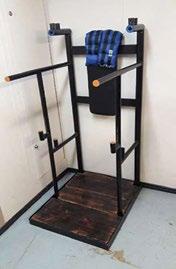


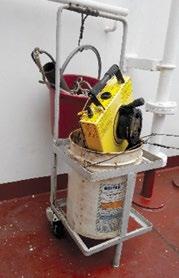



M/T Sereno
CABIN DOORS RETRO-REFLECTIVE TAPE
Retro-reflective tape was stuck on each cabin door to facilitate the crew in locating the exit during an Emergency, especially when the vessel is in Black-out.
M/V Andonis
HATCH COVER HIGHLIGHTS
The operation of hatch covers on board is routine work during cargo operations and cargo hold cleaning. The safe operation of hatch covers opening/closing is vital to crew working around the area. Hatch covers are highlighted with yellow on the corners, natural vents, hatch cover wheels and chain braces. Highlighted points on the hatch cover enhances crew awareness of moving parts when operating or working around the area. Moreover, during darkness highlighted points on the hatch cover enhances cargo holds identity at long distances during opening/closing.
M/T Pserimos
WARNING SIGN FOR SNAP BACK ZONE AREAS
Warning signs for snap back zone areas on the poop deck is usually painted on the wall (at the bulkhead of the paint store). This method of giving a warning to someone is not that effective as they are already in the snap back area before they can be alerted about the hazard by the warning sign posted on the bulkhead. Normally all crewmembers on board are aware, but sometimes visitors come on board and by putting up this warning sign, any person is already alerted before he/she can enter the identified snap back zone areas.
1. MARKING THE CARGO HOSE RAILS
Marking the Port & Starboard cargo hose rails ensures precise mooring and further monitoring of the vessel`s position variation during cargo operations. Some terminals have strict procedures regarding the position of the manifolds relative to the cargo arm. The stencils will make any alternations more impressionable.
2. CITADEL/SECURE MUSTERING POINT ENTRY CREW LIST


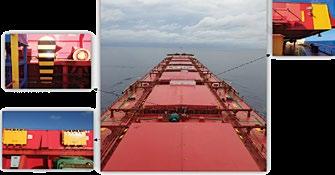


While the vessel was transiting in West Africa HRA, we came up with the idea of a semi-automatic crew list for entering the CITADEL/SECURE MUSTERING POINT. In the case of a pirate attack - hastiness and panic may occur; this can lead to crucial mistakes. The person responsible for locking the CITADEL/SECURE MUSTERING POINT must be certain that nobody is forgotten and left helpless outside. At the same time, every saved minute can be vital. To facilitate the process, every crewmember entering the CITADEL/SECURE MUSTERING POINT will tear off a badge with his rank from the board placed near the entry so that it makes it visually obvious who is still outside. The rank badges are attached to the board with Velcro so that they can be easily torn off and placed back during a Drill. Reflective tape is attached to make the badge more conspicuous and as an aid for tearing off the badge.

Finally, the Top of the Top Best Practices chosen is again Mikela P.: Fitter DAVYDKO Vitalii (on board from 30/12/20 to 25/10/21)

During the Health and Safety Meeting conducted on 22nd October 2022, the following Practice was suggested by the ship’s Fitter. A stationary gasket cutter is a useful and practical tool which was constructed onboard. It consists of 3 decks welded on a pillar:
1) Gasket cutting form and clutch
2) Tray for debris generated from cutting;
3) Holder for chisels of different diameters.
This handy tool is always on stand-by, compact, firmly secured and debris-free. It facilitates routine tasks and helps to organise the working area.
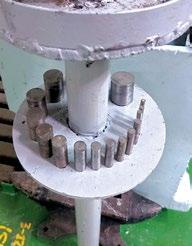

We would like to thank all our Seamen for taking the time, among their various tasks, to observe and report best practices that will not only make their lives on board the vessel safer and easier, but at the same time will improve safety on board other vessels of the Fleet. Keep up & “share” the good work!

By Chara Markatzinou
Emotional fitness is defined as the state wherein the mind is capable of staying away from negative thoughts and can focus on creative and constructive tasks. Being emotionally fit is the key to success in all aspects of life. How can we achieve emotional fitness, though? First of all, we should define its characteristics.
a. Self-Awareness
This is the ability to understand our emotional triggers and biases. It is the foundation for emotional fitness. Research shows that 95% of people believe they are self-aware, but only about 10–15% really are. The truth is there is so much we do not know what we do not know.
While self-awareness can be difficult to develop, a regular routine of self-inquiry can be created. Set up a 10-minute debrief at the end of each day to reflect on what felt good and not so good. Journal, meditate, or go for a walk to check in with yourself and be aware of what is coming up for you.
b. Mindfulness
Mindfulness is the ongoing process of becoming more comfortable with being uncomfortable. It helps us handle tough conversations, be transparent about uncomfortable information, share complicated feedback, and sit with a problem until it has been fully thought through.
The first step in developing mindfulness is getting a sense of how you relate to discomfort.
If you see yourself beginning to avoid discomfort, take a moment to reflect on whether the discomfort is really so intolerable. Sit with it for a while, take a deep breath, and prove to yourself that you can handle it. Remember, you do not need to break every silence, fix every issue immediately, or avoid difficult conversations.
c. Curiosity
Curiosity is the ability to pursue growth over defensiveness. It helps us understand and tolerate the difference between what
we want to be true and what is true. A big part of curiosity is making it a habit to ask questions, even when the answers to those questions are uncomfortable. This helps us avoid the defensive reflex and opens us up to growth.
Here are some questions you can ask when confronted with a difficult reality:
• Can you tell me more about that?
• What was that like for you?
• What could I do differently next time?
d. Play
Play is the ability to foster a safe space of connection and creativity. It is about removing constraints, meeting people where they are, and trying things on to see how they feel. This trait sparks spontaneity and creativity, and is a crucial part of emotional health and interpersonal cohesiveness.
A key part of play is building it into your daily routine. This could be as simple as starting meetings with an icebreaker game, holding an animal photo contest, or allowing yourself to be silly sometimes. The more you do it, the more natural it will become, the easier it will feel, and the more you will give others permission to do the same.
e. Resilience
Resilience is the ability to persevere and bounce back from failure and setbacks. This trait helps us understand that there is more to be learned from failure than success, and helps us to be flexible and adaptive in the face of challenge.
A great way to begin developing resilience is to start a selfesteem file. Write down or screenshot every single piece of positive feedback you receive from friends, managers, coworkers, or partners and put it in a folder you can look at when your self-confidence is low.
f. Communication
Communication is the ability to put words to needs, boundaries, and expectations. It is crucial to maintaining healthy relationships and well-being. This trait helps us talk through issues in a proactive, ongoing way. A big part of communication is being able to handle conflict effectively. When you find yourself in a disagreement with another person, try swapping positions in the argument. This loosens the attachment to being “right”, helps you see the other person’s perspective more coherently, and brings to light new points, which might make the best choice more clear.
Empathy is the ability to understand the emotions, needs, and perspectives of others. It requires us to allow ourselves to feel what others are feeling. It is a key skill for building relationships. Empathy helps us recognize that how we feel about things might not necessarily be how others feel. It also helps us seek to listen and understand even when things get difficult. Learn to be clear about what you can offer others, and what you do not have the capacity to give in any particular moment.
Resource: https://www.joincoa.com/emotional-fitness


Even though another piece had been prepared for this installment of Nostalgia, the latest developments in Ukraine pointed at a different topic for this column. The topic in question is that of hope – the hope that the conflict will end soon and that those displaced, especially the younger generation can once again create fond memories in their homeland that will serve as nostalgic moments in the future.
Our mind flies to all those who are affected, including our Seamen, serving on board the vessels, away from their loved ones. Our prayers go out to them all.

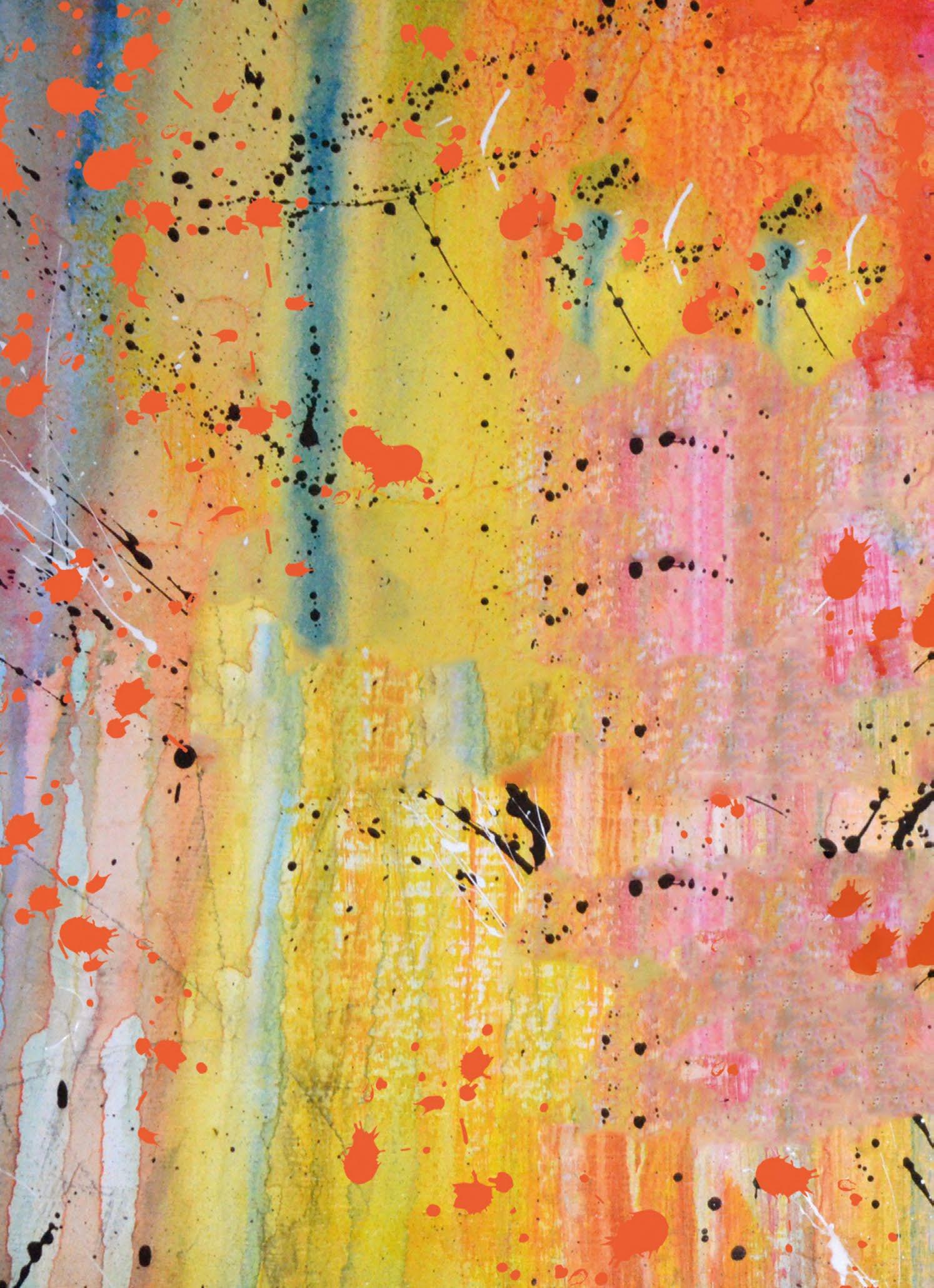

By Chara Markatzinou

“Peace cannot be kept by force. It can only be achieved by understanding.”
Albert Einstein
TV broadcasts, news alerts, even social media remind us that war cannot be a solution. Still, it remains a reality and we have to stay calm, provide our support to those in need and keep alive the hope that peace will prevail.
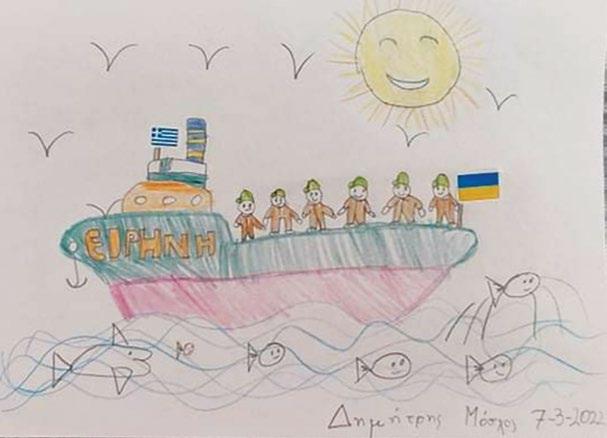
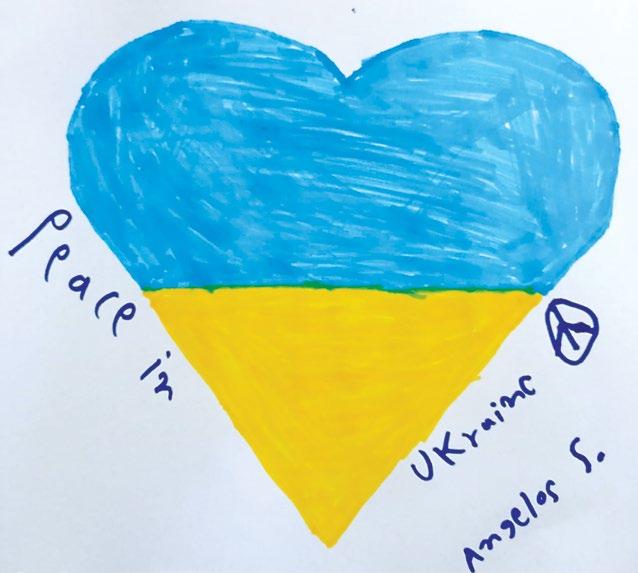
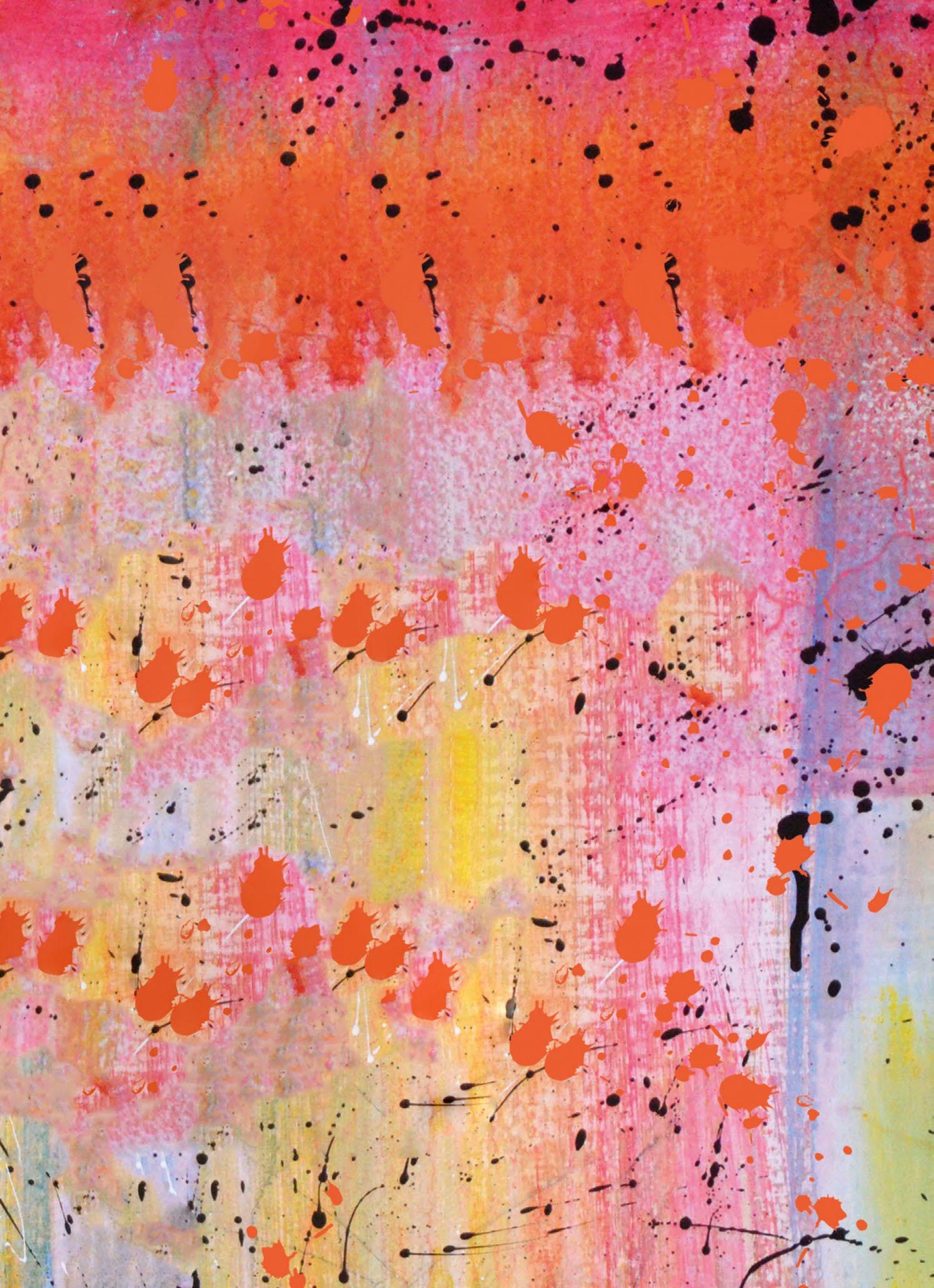


“Peace is the virtue of civilization. War is its crime.”
Victor Hugo
We wish to spread a message of hope to our Ukrainian Seamen serving on board our vessels so that they can keep their spirits high. As a positive thought can always inspire us and keep us moving, we asked the children of our colleagues to portray a hopeful message through a drawing. Children always have a pure and direct way of thinking. The energy of hope with which they have coloured their drawings with is what we wish to communicate to you.
“Just as one candle lights another and can light thousands of other candles, so one heart illuminates another heart and can illuminate thousands of other hearts.”
Leo Tolstoy


As I was writing this short piece, my heart was filled with warmth when lyrics from John Lennon’s song “Imagine” came to mind:
Imagine all the people Livin' life in peace
You may say I'm a dreamer
But I'm not the only one I hope someday you'll join us And the world will be as one
Let us pray for Peace and the world to be as one.
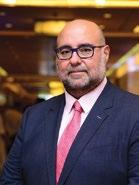
By Anthony Lambros
From the very beginning of this conflict, our Company has been trying to assist the families of our Ukrainian Seafarers, by providing safe shelter in Tulcea, Romania, a historic border city on the River Danube. We are now looking after almost 100 seafarers and their relatives, including 33 children aged between two weeks and fourteen years old. This was made possible because of the hard work, dedication and courage of our CENMAR Odessa staff, our Crew Dept. staff in Athens, the assistance and support of Rom Trust and our long-time friend, Mr. Tiberiu Duluchian. We wish to take this opportunity to publicly thank all of you for your continued actions in making this possible.
Capt. Panagiotis Bartzis and I arrived at Tulcea on April 1st 2022 in order to visit our people and ensure they are well taken care of. We visited the hotels where the families are being accommodated and in the evening hosted a dinner at City Hotel, during which we distributed clothing and toys that


had been collected and generously contributed by all our office staff in Greece. I set out to speak a few words of comfort to our families, but I soon realized that words were too little to live up to the atmosphere in that room. I cannot express the gratitude and thanks I received from our families. I felt emotionally overwhelmed and moved in a way I cannot describe (of course, my getting older and more sentimental doesn’t help…).
There were so many faces, each with a different story, each with a different journey, each with different thoughts. There were so many faces with a common starting point, and all of them – all of us – in that room, at that time, with a single goal, a single hope, a single prayer: peace.
Soon the beautiful children were playing and running around, chasing each other, laughing and having a good time, lively as ever. Slowly, the adults felt a bit better, started talking and smiling, and perhaps put some of their worries behind them –at least for a while. Seeing these courageous and positive faces I came as close as one ever can to the meaning of the saying “Life will always find a way”

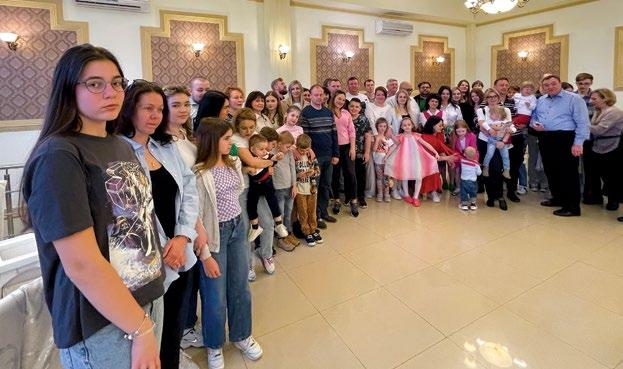

Although plastics were well known in the 19th century, the first truly synthetic plastic was created by Leo Baekeland, a Belgian chemist, in 1909. Called Bakelite after its inventor, it had properties which made it perfect for use in several industries. Being heat resistant and a non-conductor of electricity gave rise to its adoption by the emerging automotive and electricity industries. Bakelite was easily moulded, lightweight and durable, so manufacturers used it to make such items as lamps, radios, telephones and tableware. It was even used to make jewellery to take advantage of its aesthetic qualities and high-end feel. Bakelite’s rein lasted until the 1950s, when superior alternatives were invented. Bakelite was joined by other plastics before the 1950s and the momentum it started to give to the ‘plastics revolution’ over 100 years ago has not decreased since. The timeline below shows some of the major milestones in the ‘evolution’ of plastics.

Although the timeline is not exhaustive, it is a clear indicator of how widespread the use of plastics has become. This is reflected in production figures and the introduction of additives into long chain polymers to suit the purpose of the manufactured plastic. As regards production, 2.3 million tons of plastic reached the market in 1950. Sixty five years later, in 2015, this figure had risen to 322 million tons and to 368 million tons in 2020. The acceleration in the production of plastics can be realized in the statistic that half of all the plastics ever manufactured have been made in the last 15 years.
50% of all plastics ever produced have been manufactured in the last 15 years
Once it became known that is was relatively easy to introduce additives into polymers to change the properties of a plastic, chemists found ways manipulating molecules to increase the diversity of plastics that reached consumers. They made plastics sticky, slippery, soft, hard, foamy, light and stretchy to name just a few adaptations. The benefits of such variations in the properties of plastics led to their adoption in every industry and a wide variety of chemicals being introduced into the environment.
Biocide As, Sn compounds
Heat Stabilizer Cd, Pb, Ba, Ca salts
UV Stabilizer, antioxidant Cd, Pb compounds multitude of organics
Colorant Co, Cd, Cr compounds, Al, Cu compounds
Flame retardant Br, Sb, phosphates
Increase slipperiness Fatty acid amides
Table showing just a few uses of plastics and the associated additives, some of which are highly toxic
Plastics in the Marine Environment
It is difficult to give the precise amount of plastics in the marine environment, but estimates from informed sources place it at
around 8 million tons. As the most common form of marine debris, plastics are wreaking havoc in our seas. Marine life gets caught in derelict fishing nets and other debris while certain marine creatures mistake plastics for food and can suffer a slow death as a consequence. These two scenarios are visible and are, therefore, well documented, but this ubiquitous material has other less obvious dangers associated with it.
8 million tons of plastic in our seas
As plastics do not decompose unless they are biodegradable, they either remain intact in the ocean, or break down into smaller pieces through the actions of the wind, waves and sun. Known as microplastics when they are 50μm to 5mm in size, these small fragments are easily ingested. Indeed, microplastics together with their additives have been found in over 100 aquatic species. What is more, since additives are able to migrate from plastics into the marine environment and certain plastics have the ability to absorb such additives there may be elevated concentrations in some microplastics.
Microplastics found in over 100 aquatic species

Although the aftermath of a vessel catching fire and sinking with a cargo of 1,700 tonnes of plastic pellets of Colombo, Sri Lanka in 2021 is a rare type of event, it nevertheless highlights the dangers associated with having plastics in our ocean. When the ship sank many pellets were released. In response, the Sri Lankan authorities requested an analysis of the debris to be conducted by Sweden’s International Pollutants Elimination Network (IPEN) and Sri Lanka’s Centre for Environmental Justice (CEJ).
Their findings gave cause for concern. IPEN and CEJ determined that the levels of lead (Pb) and cadmium (Cd) in intact and burnt debris were up to 6 times higher than EU limits for consumer products. In addition, there were elevated levels of different compounds of polyaromatic hydrocarbons (PAH), 7 of which are suspected carcinogens.
On receiving the results of the analysis, the Sri Lankan authorities closed off the area to fishing. This had an immediate impact on the livelihoods of around 7000 families connected to the region’s fishing industry. The event also highlighted the potential danger of accidents involving ships that are now carrying more and more complex mixtures of chemicals and plastics, and the need for action to safeguard the transportation of such cargoes.
Plastics that burden the marine environment originate from both land and ocean based sources. Debris incorrectly disposed of on land can easily reach the sea via streams, rivers and storm drains. It can also be swept in the ocean by winds, rainfall and via irrigation channels. At the heart of the problem is single use
Put simply, palak paneer is a dish that combines spinach and cheese, but this description does not begin to cover the taste and nutrition aspects of the Indian favourite that originated in Punjab. This region of India has vast areas of fertile land that is particularly suitable for growing vegetables, including leafy greens like spinach. It is also known for its dairy products and since vegetarian dishes are popular in the country, palak paneer is a firm favourite.
The choice of spinach (palak) for an Indian dish also makes way for the addition of spices, which are an integral part of the cuisine in this part of the world. Besides forming a perfect base for spices, spinach welcomes fresh cheese in the form of paneer in this case. It is a combination savoured in many other parts of the world where the magic of the spinach-cheese union has become part of the food culture.
In palak paneer the spinach is boiled and then pureed. As regards the other chief ingredient, paneer, this is a fresh cheese that is made by adding an acidic component to boiling milk in order to curdle it. Curdling agents include lemon juice, vinegar (which has the advantage of acting fast but can introduce unwanted flavour if too much is used), butter milk, yoghurt and citric acid. After the curdling process has been completed, the mixture is drained thoroughly through cheese cloth and the solids are pressed and diced into cubes. These cubes are fried for the dish.
Other ingredients that can be incorporated into palak paneer
plastics and the increasing production of disposable plastic items.
We have become so used to the convenience offered by plastic products that severing our ties with them quickly is not a realistic option. Instead, used plastics should be collected in an efficient manner, recycling and upcycling rates need to be increased whenever possible and methods of distancing ourselves from the throw-away culture we have so readily embraced, need to be formulated and implemented. Moreover, the existing projects to clean up garbage patches in the sea need to be scaled up as do beach clean-ups.
The phrase ‘Planet Plastic’, which has been coined to describe the current situation, may not be far off the mark, especially with regard to the ubiquitous nature of plastic. Irrespective of its origin, plastics have been found high on Mount Everest and in the depths of the Mariana Trench. They have also been found in the Pitcairn Islands after having set out from the US, Europe, South America, Japan and China.
Once plastics get into the marine environment, the world is their oyster, so to speak. Ocean currents can sweep them to every corner of the aquatic world and create problems for marine creatures and humans alike. It is, therefore, imperative that plastics should be kept away from the sea at all costs, whatever they may be.
Sources: www.bpf.co.uk, www.plasticsmakeitpossible.com, www.sciencedirect.com www.oceanservice.noaa.gov, www.marine.copernicus.eu, www.nationalgeographic.com www.maritime-executive.com
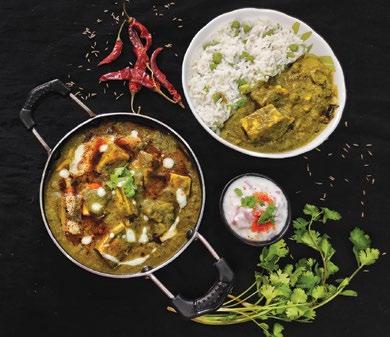
are oil, turmeric, cumin, onions, ginger, garlic, red chilli powder, coriander powder, tomatoes, salt, masala powder and cream. As far as the nutritional value of palak paneer is concerned, the main ingredients are the chief contributors. Spinach contains vitamins A, C, K1 and B9 and iron, while paneer cheese is rich in protein and calcium. Health benefits include a boost to the immune system, improved cell and tissue growth, an aid to digestion and the maintenance of blood sugar levels. Teeth, bones, the metabolism, the heart and muscles are also catered for by palak paneer and the list grows when the other ingredients are taken into account.
The side dishes available for hot palak paneer are a choice of breads in the form of roti, naan bread and maki diroti or boiled rice. Bread made with flour from maize provides iron, phosphorus, zinc, vitamins A, C and K as well as beta-carotene and selenium. All these nutritious ingredients in a tasty, filling meal makes palak paneer a firm favourite of Indian cuisine.
Sources: www.healthline.com, www.lybrote.com, en.wikipedia.org, www.dawn.com, www.foodviva.com
An ethnic group with origins in Southeast Asia, the Bajau people, whose culture is founded on their close connections with the sea, were almost unknown to the outside world until the 18th century. For hundreds of years before then and until fairly recently they lived a migratory existence. As so-called ‘nomads of the sea’ they had no official ties to a particularly country, which means that their history lies in their folklore, traditions and culture that has been handed down orally and practically from generation to generation.
Today, there are an estimated 500,000 Bajau people that reside in the waters off the Philippines, Indonesia and Malaysia, but their houseboats have virtually disappeared and have been replaced by houses on stilts close to the shore. The main reason for this is that the trees once used to build their boats are now endangered. The light wood they provided was substituted by heavier wood, but the heavier houseboats required fuel, the cost of which was prohibitively high for the Bajau.
What has not changed is the Bajau’s reputation for producing the most accomplished divers and fishers in the world. It comes as no surprise, therefore, that their living is made almost exclusively from fishing, either by using nets or by freediving. The latter technique occurs in and around reefs where nets are useless. It is in these areas where the best Bajau free-divers, wearing their wooden goggles and carrying their spearguns, ply their trade.
Every day they leave their village of houses on stilts above the water, which can be home to around 1000 people, for their fishing grounds. When they arrive they dive for an average of 30 seconds, but whenever necessary they can stay under water for 5 minutes and in rare cases significantly longer. These longer dives often include a walk on the sea bed, where some of the 3,500 species of fish living on the reefs are sought. In addition to being able to reach depths of over 200ft (61m), the Bajau divers can spend up to 5 hours under water per day to catch up to 18lb (8.1kg) of fish and octopuses.
The first priority for the Bajau fishermen is to catch enough fish to feed their family and others in their community. Any surplus is taken to market where Bajau women in boats sell to their customers on a pier. With the money they earn they buy such as rice, bananas and coconuts. The responsibility of the women to barter at market is not down to the belief that this is women’s work, but that according to Bajau women, their menfolk are poor at making financial transactions. In addition to selling produce at local markets, the Bajau harvest a sea cucumber called trepan, which is sold for culinary and medicinal purposes in places as far away as China.
While they may not be world beaters at managing money, the male apnoia divers have attracted the interest of scientists across the globe. What is more, geneticists have conducted studies to determine whether the Bajau free-divers have attained their breath-holding ability through differences in their genetic make-up. So far, researchers have identified three genes that could support the genetic hypothesis. One, which is active in the thyroid gland, causes spleens to grow larger. When a person or mammal’s breath is held, the spleen contracts, red blood cells stored in the spleen that transport oxygen in the body are released. In the largest spleens, which are found in all the best free-divers, significantly more oxygen is available to the

A Bajau village. Source: en.wikipedia.org
body when under water. A second gene, which is also linked to free-divers, including the Bajau, is responsible for controlling oxygen circulation to vital organs. The third gene being studied influences the levels of carbon dioxide in the blood. It is also a gene common in people living at high altitudes like Tibetans.
Apart from gaining an understanding of the Bajau divers’ abilities, these studies may have much wider implications. For instance, there is potential for thousands of lives being saved in hospital emergency rooms, where acute hypoxia often causes patients to die. As the dive response is similar to the hypoxia response, the Bajau divers may hold the key to minimizing this risk to those suffering medical emergencies.

Source: www.weizmann-usa.org
The ability of the Bajau to adapt to their environment has served them well. Their diving prowess, which is likely to be attributable to genetic factors, has allowed them to maintain their livelihood. Their move away from a purely nomadic lifestyle has made their lives easier without inflicting much of a negative impact on their cultural connection with the sea. Therefore, despite fears for their future, it appears that with the appropriate government assistance where necessary, the Bajau people have clearly proved they are survivors.
Sources: www.historyofyesterday.com, www.allthatisinteresting.com, www.abysseofficial.com www.theatlantic.com, www.youtube.com

The Suez Canal in 2015. Source: en.wikipedia.org
Plans to build a canal across the Isthmus of Suez in Egypt were considered well before construction of the Suez Canal began in 1859, but they never materialized. Five years prior to construction, Ferdinand de Lesseps was provided with an Act of Concession to build a canal and two years later a second act was conferred on the Suez Canal Company, giving the organization the right to operate the Canal for 99 years.
It was estimated that the Suez Canal would be completed in six years, but delays caused by climatic conditions, a cholera epidemic and labour difficulties extended the construction period to ten years. By the time the Suez Canal was completed, head of the project, Ferdinand de Lesseps together with his teams had produced a channel that was 164km long with a depth of just 8m (26ft) and widths of 22m (72ft) at the bottom and 61-91m (200300ft) at the surface.
The narrowness of the original Suez Canal made navigation difficult and as a result, there were approximately 3000 groundings during the first 14 years of operation. Since then there have been a number of projects undertaken to deepen and widen the Suez Canal. The two largest were in 1960 and 2015. In the former, the minimum width was extended to 55m (179ft) and the depths to 10m (33ft) along the banks and to 12m (40ft) in the channel at low tide. The latter, an $8.5bn project, added a further 29km to the length of the Canal, taking it to 193km (120 miles).
Due to its original narrowness, the Suez Canal could not cater for two-way traffic and ships had to stop in bays to allow passage to oncoming vessels. This made for an average transit time of around 40 hours for the 486 vessels that made the voyage in the first year of operation and in the years until the Suez Canal was widened. Traffic volume peaked in the mid-1960s with 21,250 transits recorded in 1966. By the mid-1980s the number of transits had dropped by around 15%. However, tonnage increased, as was the case in 2018, when there was a further slight drop in the number of transits. As regards passenger traffic, liner transits peaked in 1947, when 984,000 passengers witnessed the spectacular Suez Canal views first-hand. Since its heyday, passenger traffic has almost ground to a halt due to air travel having become widely accessible.
For the most part, traffic has flowed smoothly along the Suez Canal, but there have been some blips from blockages. However, these pale in comparison with the closures of the Canal during the Suez Crisis (1956-7) and the 2nd Arab-Israeli War (1967), after which time the Suez Canal remained closed until 1975.

All these facts have been well documented, but there are some that are not so well known. One of these concerns a request from Fréderic-Auguste Bartholdi, the creator of the Statue of Liberty, to Ferdinand de Lesseps and the Egyptian government to allow him to construct a 90-foot (27.4m) tall statue of a woman at the Mediterranean entrance to the Suez Canal. The artist proposed that the figure should be clothed in Egyptian peasant robes, hold a huge torch and serve as a lighthouse. The project never materialized but Bartholdi continued to promote his idea that was inspired by the ancient Colossus of Rhodes. In 1886, his vision became a reality in the form of “Liberty Enlightening the World” located in New York Harbour. Another concerns Ferdinand de Lesseps attempt to construct the Panama Canal. Work on this project began in 1881, but the difficulties encountered proved much greater than the engineer had anticipated. The location, disease as well as the hot and humid jungle forced the project to fail at a cost of almost $260m.
There can be little doubt that the Suez Canal, one of the world’s most heavily transited waterways, has a very interesting history. What is also certain is that this Egyptian stretch of water plays a vital role in the shipping of valuable cargoes principally between Europe and both the Indian and the west Pacific Oceans.
Sources: www.britannica.com www.history.com en.wikipedia.org
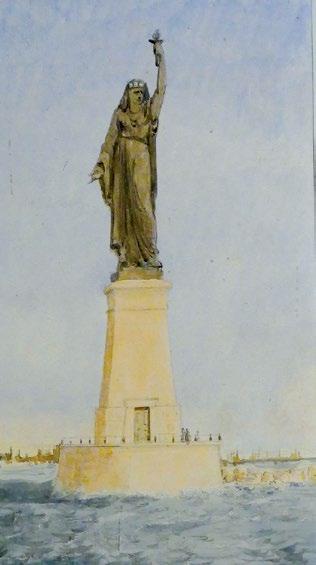
1. Make the names of two countries using all the letters in the following sentence: MAE SHUNNED ROY
2. The letters in the chemical symbols for gallium, neodymium, potassium and sulphur can be rearranged to form the name of a port in Europe. What is the name of the port?
3. I am where people sometimes meet, to take a walk or sit on a seat. Buying a house near me may require wealth, but I am proven to be good for your health. What am I?
4. Which four-letter word can be used to complete the following words:
S _ _ _ _ ING, RE _ _ _ _ ER, IM _ _ _ _ ED and OP _ _ _ _ UNE?
5. 5.Oleg has strong preferences. His favourite sport is tennis, his favourite artist is Picasso and his favourite flower is the sunflower. He enjoyed his trips to Oman and Vanuatu, and found Lubbock, a
1. With which island is the cultural heritage of phinisi boatbuilding associated?
A. Sulawesi B. Borneo C. Palawan D. Bali
2. What is the principle of operation for a mechanical sail based on?
A. Bernoulli principle B. Coanda effect
C. Reynolds number D. Magnus effect
3. Which country has the longest coastline in the world?
A. Indonesia B. Canada C. Russia D. China
4. How long was the German battleship, Bismark?
A. 392.5m B. 410m C. 430m D. 450.5m
5. How much time must elapse before a High Impact ship incident is removed from the database that affects the score given to a vessel following a Rightship inspection?
A. 3 years B. 4 years C. 5 years D. 6 years
6. The first oil field in the North Sea was established in 1971. Which country was the first to extract oil from this region?
A. The UK B. Norway C. Denmark D. Germany
town in Texas to be perfect. By the same token, which fruit would he prefer: a banana or an orange? Why?
6. Which five-letter word can be placed after the words to the left and before the words to the right?
ATOMIC
- - - -NAP BRAIN DRILL WILL BOOST
7. In 5 steps change the word CASH to NOTE by changing one letter at a time to form intermediate words.
8. A team of 4 bricklayers take 15 hours to build a wall that is 25m long and 3m high. How long will it take a second team to build a wall that is 20m long and 2.7m high if they build at 90% of the speed of the first team?
7. In the maritime abbreviation, ICS, what does the ‘C’ stand for?
A. Control B. Classification
C. Cargo D. Chamber
8. In which US state is the sail superstructure of the USS Triton located today?
A. California B. Connecticut
C. Washington D. Maine

9. On the coast of which sea does the Russian port of Murmansk lie?
A. Baltic Sea B. Black Sea
C. Bering Sea D. Barents Sea
10. Which port contains a UNESCO world heritage site on which there is a monument against the largely Angolan slave trade that was established in the first half of the 19th century?
A. Rio de Janeiro, Brazil B. Savannah, USA
C. Boston, USA D. Suape, Brazil
Find a keyword associated with several articles in this issue by solving the clues and rearranging the letters in the boxes with black borders.
1. Foodstuff that can spontaneously combust (7)
2. Vessel on which monggo soup is a favourite (8)
3. Capital of the Marshall Islands (6)
4. People living in houses over the sea (5)
5. Greek submarine sunk in November 1942 (6)
6. A trait of mental well-being (9)
7. Material used in Best Practice from M/T Mikela P. (6)
8. Future marine fuel (7)
Hint: These people solve problems

Triton was a Proteus Class submarine of the Hellenic Royal Navy that was built at the Ateliers & Chantiers de la Loire Shipyard in Nantes, France. She was launched on 4th April 1928 and commissioned on 1st March 1930. Triton was the 3rd of four submarines of this class built for the Hellenic Navy in the late 1920s, the others being Protefs, Nirefs and Glafkos. At 750 tons (surfaced), Triton was 68.6m (225ft) long with a beam of 5.73m (18.8ft) and a draft of 4.18m (13.7ft).Her top speeds were 14 knots at the surface and 8.5 knots submerged. Triton’s war missions began in the Greek-Italian War, when she conducted patrols in the Ionian Sea. These and other duties were interrupted when Greece became occupied by Germany. At that point in WWII, Triton sailed for Alexandria. From the Middle East she completed 7 patrols and one voyage to Malta, where she delivered supplies before returning to home waters.
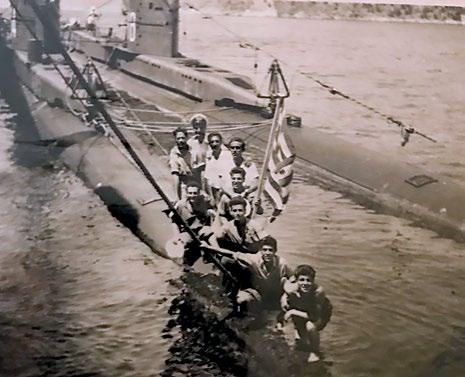
gyroscopic compass. At 21:00 Triton ascended to use its periscope. UJ2102 was spotted heading toward her at great speed. Triton then submerged to a depth of 30m where it was attacked with 9 more depth charges resulting in the loss of the right engine amongst other significant damage. The commander of Triton had two choices: ascend and surrender, or fight. He chose to fight.
On November 10th 1942, the submarine began her 15th and final mission to Northern Euboea in order to drop off 5 agents and 340 kg of war supplies. On 16th November Triton reached her destination. However, the mission was delayed due to bad weather. At 16:00 the crew spotted an enemy hydroplane and descended to a depth of 30m to evade it. At 16:20 it ascended in order to use its periscope and spotted an enemy convoy which it decided to attack. While approaching the convoy she changed course, heading northeast for a better angle of attack. At 16:30 from a distance of 5.5km Triton launched an attack on the convoy, firing one torpedo which did not find its target.


Triton had been spotted by UJ-2102, which remained at a distance of 1.400m and did not follow the convoy. At 16:40 UJ-2102 launched its first attack with 13 depth charges set for a depth of 70 to 125m. At 17:00 there followed a second attack with 11 depth charges which did not cause any significant damage to Triton. After several manoeuvres, at 20:05, UJ-2102 launched its third attack against Triton with 13 more depth charges which managed to cause significant damage. Although damaged, the submarine remained operable and attempted to escape. However, because the external fuel tanks were breached the oil that leaked to the surface gave Triton’s position away. At 20:30 a fourth attack was launched dropping 12 more depth charges which caused significant damage and made steering impossible and disabled the
At 22:00, five and a half hours after the first attack, the Commander of Triton, E. Kondogiannis, ordered the submarine to surface and fire with a machine gun. As soon as they reached the surface the Commander fired his revolver at UJ2102 and then attempted to fire with a machine gun. UJ-2102 then fired at the submarine. The Commander then lost consciousness due to the shock and fell into the sea whilst the crew opened fire with machine guns at UJ-2102. At 22:14 UJ2102 using all its guns attacked Triton one more time after which began the evacuation of the submarine.
From the surviving crew, 28 surrendered or were found unconscious, including Commander Kondogiannis, while Nikolaos Maroulas and D. Papadimitriou escaped by swimming to shore, seeking refuge at the nearby village of Thimiani and finally fleeing to the Middle East. The crew that had opened fire with machine guns were all killed, and were among the 23 who perished. Christos Soliotis, who was the last person on board Triton, opened the ventilation in order to sink it faster and not let the submarine be taken by the enemy.
The crew that was captured received medical aid from the German UJ-2102. After being interrogated they were transported to the prison of war camp “MARLANG”, where they remained until their liberation from the allied forces on 28th April 1945. Triton’s flag remained in the hands of the Commander of UJ-2102 until 20th September 1972, when it was surrendered to Ioanni Maniati in a special ceremony at the Mürwik Naval School. Today Triton’s flag can be found on display at the submarine base in Salamina. This story is not only particularly relevant because it is part of Greek Naval history but it has a connection to the Company. More specifically, one of the survivors on board Triton was 2nd Engineer, Evaggelos Kollintzas, the grandfather of his namesake who currently works in the Chartering Department at Head Office in Glyfada.
Sources: el.wikipedia.org, www.uboat.org , en.wikipedia.org, www.hellenicnavy.gr www.mixanitouxronou.gr